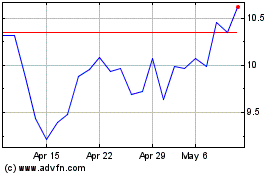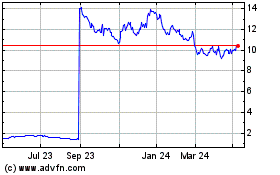The Russian passenger jet that crashed in Egypt's Sinai
Peninsula with 224 people on board broke apart in flight and debris
from the tail section was found separate from the rest of the
fuselage, suggesting that section may have split off in the air,
according people familiar with the investigation.
Russian authorities suggested the cause of Saturday's crash was
likely a mechanical failure, though it was too early to draw a firm
conclusion. The midair breakup left debris scattered over
approximately 20 square kilometers, the head of the Russian-led
Interstate Aviation Committee, Viktor Sorochenko, said Sunday.
The plane involved had suffered substantial damage in 2001 when
the tail struck the runway on landing in Cairo, according to the
Flight Safety Foundation's Aviation Safety Network. That event has
captured the attention of safety experts and investigators given
that the tail section debris was located apart from the rest of the
plane, according to two people knowledgeable about early steps of
the investigation.
After climbing gradually to more than 33,000 feet, the jet
dropped some 6,000 feet in about 22 seconds, according to
preliminary radar data posted Saturday by a commercial website. In
roughly 60 seconds, the data shows the plane's speed dropping to
about 100 miles per hour, slower than the forward speed needed to
continue safe flight. According to the data, which hasn't been
confirmed by investigators, the plane had been cruising at roughly
460 miles per hour.
Both of the plane's black boxes, which record flight data, were
recovered on Saturday and will be analyzed starting Sunday, said
Mohamed Rahma, a spokesman for Egypt's civil aviation ministry.
"It's too early to speak of conclusions," Mr. Sorochenko told
journalists in Cairo after inspecting the crash site, according to
Russian state news agencies. "The breakup happened in the air."
The Airbus A321, operated by Russian carrier Kogalymavia, was
flying to St. Petersburg, Russia, from the Egyptian resort of Sharm
El Sheikh, a popular destination for Russian tourists.
The Egyptian affiliate of Islamic State, which is known as Sinai
Province and is active in the restive peninsula, claimed
responsibility for downing the plane and said it was in response to
Russia's intervention in the Syrian war on the side of the regime.
Syria's Shiite-linked regime, which is backed by Iran, is fighting
the Sunni extremists of Islamic State among other foes.
Several airlines suspended flights over Sinai until more is
known about the cause of the crash. United Arab Emirates budget
carriers flydubai and Air Arabia said Sunday they were rerouting
flights after Air France-KLM, Deutsche Lufthansa AG and Emirates
Airline said they were avoiding the Sinai region.
Islamic State and its affiliates have frequently made
exaggerated claims, and Russian officials said they doubted whether
the group has the capabilities to carry out such an attack. U.S.
and European air safety officials, who had previously warned
airliners about the threat of antiaircraft weapons in the region,
believe flying above 26,000 feet is safe.
The Russian plane was above 30,000 feet when it appears to have
broken up.
Conflicting reports about the extent of the debris field—and how
far some tail sections actually landed from other portions of the
fuselage—made many safety experts cautious about drawing firm
conclusions on Sunday. But the relatively large size of some pieces
of wreckage appeared to buttress the notion that the plane hit the
ground at a relatively slow forward speed.
If wreckage is dispersed over 20 square kilometers or so, that
strongly suggests an in-flight breakup, according to industry
consultant John Cox, a former airline captain and senior crash
investigator for the county's largest pilots union.
"It's very hard to believe the airplane would have come apart
without some major structural or maintenance problem," he said
Sunday.
An Egyptian team was searching for evidence and victims. Of the
224 people believed to have died in the crash, 163 bodies have been
recovered so far.
"We are coordinating with the Russians to secure their
transportation back home," said Mr. Rahma, the Egyptian civil
aviation ministry spokesman.
A Russian team has begun working with the Egyptian government's
investigative committee. Officials from Russia's emergency,
civil-aviation and transport ministries, accompanied by experts
from the country's civil-aviation ministry, arrived in Cairo late
on Saturday.
"Investigations are under way and the government committee is
currently at the crash scene," said Mr. Rahma,
The plane was built in 1997 making it one of the oldest A321s in
service. It had logged almost 21,000 flights and 56,000 flight
hours, Airbus said Saturday. In 2003, it was sold to Onur Air and
flown by the Turkish carrier as well as leased, at times, to Saudi
Arabian Airlines and Syria's Cham Wings, before being sold to
Kogalymavia, which operates as Metrojet.
The aircraft had undergone all the required maintenance checks,
Kogalymavia has said.
Still, when an accident or incident prompts significant
structural or bulkhead repairs to a jetliner, the carrier typically
consults the manufacturer and often wants it to sign off on how the
work is slated to be done.
It isn't clear what occurred when the A321 was repaired years
ago after the 2001 tail strike, or whether the work involved
bulkhead repairs.
But safety experts have been aware of the hazards of incorrectly
repaired bulkheads for more than a decade. In 2002, a China
Airlines jumbo jet en route to Hong Kong from Taiwan broke apart
shortly after takeoff, killing all 225 people aboard.
Investigators determined the in-flight rupture was caused by
improper bulkhead repairs many years earlier.
Even before detailed downloads of the recorders are completed to
create a precise accident timeline, the debris may provide
important clues. The pattern and type of metal fractures, according
to safety experts, frequently can indicate how the plane came
apart. In previous crash probes, such analysis helped point to
everything from fuel-tank explosions to missile strikes.
This time, according to these experts, most pieces of the plane
are relatively easy to access and therefore may help investigators
quickly eliminate theories that don't fit the physical
evidence.
Egypt has in recent years built up its technical capacity to
handle air-crash probes, including the ability to extract
information from cockpit voice and flight-data recorders quickly,
according to an aviation-safety expert familiar with the country's
efforts.
Authorities could have useful information available in a few
days or even hours once they start extracting data from the black
boxes.
Egypt is leading the probe, as per international rules, and will
be assisted by experts from plane maker Airbus Group SE as well as
the French and German air-crash investigation offices.
Moscow sent aircraft with first responders and forensic
investigators to Egypt on Saturday to assist in the recovery.
The Russian Embassy in Cairo said an additional two aircraft
from Russia's emergency situations ministry arrived in Egypt on
Sunday.
A team of more than 100 Russian first-responders were on the
ground by Sunday.
Egypt's top prosecutor, Nabil Sadeq, has ordered restricted
access to the crash site.
Journalists haven't been allowed to visit the scene, as part of
an overall restriction in Sinai because of continuing military
operations against militants in the northern part of the
peninsula.
Nathan Hodge and James Marson contributed to this article.
Write to Robert Wall at robert.wall@wsj.com
Access Investor Kit for "Deutsche Lufthansa AG"
Visit
http://www.companyspotlight.com/partner?cp_code=P479&isin=DE0008232125
Subscribe to WSJ: http://online.wsj.com?mod=djnwires
(END) Dow Jones Newswires
November 01, 2015 20:45 ET (01:45 GMT)
Copyright (c) 2015 Dow Jones & Company, Inc.
Air FranceKLM (EU:AF)
Historical Stock Chart
From Mar 2024 to Apr 2024

Air FranceKLM (EU:AF)
Historical Stock Chart
From Apr 2023 to Apr 2024
